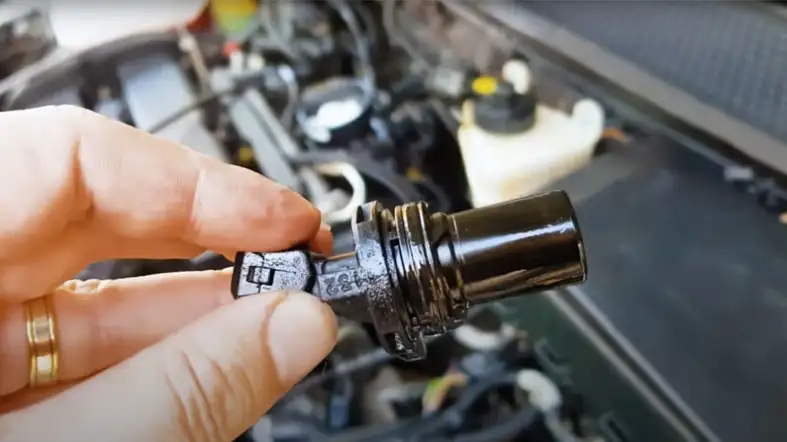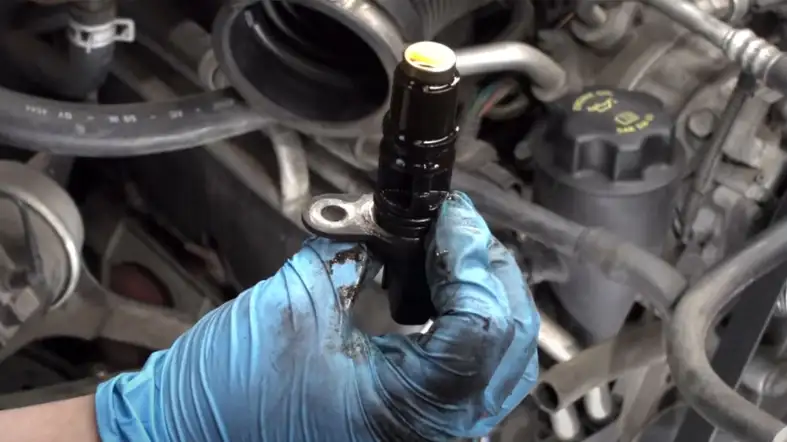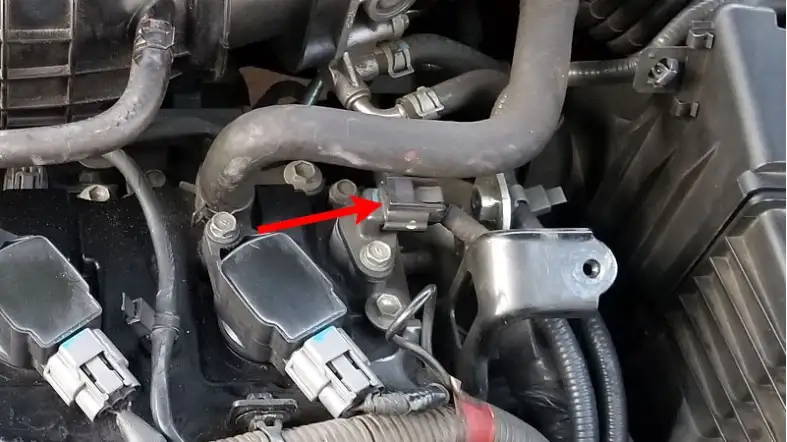If you’re a car enthusiast or just a regular driver, you might have heard of a component called the camshaft position sensor.
This little device might seem insignificant, but it plays a crucial role in your engine’s performance.
Without it, your engine won’t be able to run efficiently or even start at all!
Unfortunately, like any other mechanical part, camshaft position sensors can go bad over time, and when they do, it can cause a variety of problems.
In this blog, we’ll explore what causes a camshaft position sensor to go bad and what signs to look out for when it does.
What causes a camshaft position sensor to go bad?
The camshaft position sensor is a small device that monitors the camshaft’s position and sends that information to the engine’s computer.

The computer then uses that information to adjust the engine’s timing and fuel delivery, ensuring that the engine runs smoothly and efficiently.
Now, let’s take a look at some of the most common reasons why a camshaft position sensor might fail:
1. Electrical issues: Like any electrical component, the camshaft position sensor can be affected by issues such as corrosion, damaged wiring, or a faulty connection.
These issues can cause the sensor to malfunction or fail altogether.
2. Exposure to heat: The camshaft position sensor is located in the engine compartment, where it is exposed to high temperatures.
Over time, this heat can cause the sensor’s components to degrade, leading to failure.
3. Contamination: The engine compartment can also be a dirty and dusty environment, and contaminants such as dirt, oil, and debris can find their way into the sensor.
These contaminants can interfere with the sensor’s operation and cause it to fail.
4. Mechanical damage: The camshaft position sensor is a delicate component that can be easily damaged if it is bumped or jostled. In some cases, the sensor may even be damaged during routine engine maintenance, such as when the camshaft is removed for repair or replacement.
5. Normal wear and tear: Finally, like any component in an engine, the camshaft position sensor can simply wear out over time.
This can be due to factors such as high mileage, poor maintenance, or simply the natural aging process of the component.
Symptoms of a Failing Camshaft Position Sensor

If the camshaft position sensor begins to fail, it can lead to a variety of symptoms that can affect the performance and safety of your vehicle.
Here are some of the most common symptoms of a failing camshaft position sensor:
1. Check Engine Light: One of the most obvious signs of a failing camshaft position sensor is the illumination of the check engine light on your dashboard.
This warning light will typically come on when the sensor is not functioning properly, indicating that there is an issue with your engine system.
2. Rough Idling: If your engine is idling roughly, it could be due to a faulty camshaft position sensor.
The sensor provides information to the engine’s control module, which then adjusts the fuel injection and ignition timing accordingly.
If the sensor is not working properly, the engine may not run smoothly at idle.
3. Stalling: A failing camshaft position sensor can also cause your engine to stall or even shut off completely while you’re driving.
This can be a dangerous situation, especially if it happens while you’re driving at high speeds or in heavy traffic.
4. Poor Acceleration: Another symptom of a failing camshaft position sensor is poor acceleration.
The sensor helps to control the fuel injection and ignition timing, which are critical to the engine’s ability to accelerate smoothly.
If the sensor is not working properly, the engine may hesitate or jerk when you try to accelerate.
5. Reduced Fuel Efficiency: A failing camshaft position sensor can also cause your vehicle’s fuel efficiency to drop.
This is because the engine may not be receiving the correct information about the position of the camshaft, which can lead to inefficient combustion cycles.
6. Difficulty Starting: In some cases, a failing camshaft position sensor can make it difficult to start your vehicle.
This is because the sensor provides information to the engine’s control module, which then determines when to fire the spark plugs and inject fuel.
If the sensor is not working properly, the engine may not start at all or may take longer than usual to start.
How to Diagnosis Camshaft Position Sensor Failure?
When the camshaft position sensor in your vehicle begins to fail, it can cause a variety of issues with the engine’s performance.
Here are some common symptoms to look out for if you suspect a camshaft position sensor failure:
1. Check engine light: A failing camshaft position sensor can trigger the check engine light on your dashboard.
2. Engine misfires: When the camshaft position sensor is not functioning properly, it can lead to misfires in the engine, which can cause a rough idle, poor acceleration, and reduced power.
3. Stalling: If the camshaft position sensor is not working correctly, it may cause your engine to stall or cut out while driving, especially at low speeds or while idling.
4. Difficulty starting: A faulty camshaft position sensor may cause your engine to struggle to start or fail to start at all.
5. Decreased fuel efficiency: If your camshaft position sensor is malfunctioning, it can cause your engine to consume more fuel than usual, resulting in decreased fuel efficiency.
If you notice any of these symptoms, it’s important to have your vehicle inspected by a qualified mechanic.
They can perform a diagnostic test to determine if the camshaft position sensor is the cause of the issues you are experiencing.
How to prevent a camshaft position sensor from going bad?

A faulty camshaft position sensor can cause a range of problems, from poor performance to engine failure.
To prevent this from happening, here are some tips to keep your camshaft position sensor in good condition:
1. Regular Maintenance: Regular maintenance is crucial to keep your car running smoothly.
Follow the manufacturer’s recommended maintenance schedule and take your car to a trusted mechanic for regular check-ups.
During these check-ups, the mechanic should inspect the camshaft position sensor for any signs of wear or damage.
2. Avoid Rough Driving: Rough driving can cause excessive wear and tear on the engine, including the camshaft position sensor.
Avoid aggressive driving, sudden stops, and hard acceleration, as this can put extra stress on the sensor.
3. Keep Your Engine Clean: A clean engine runs more efficiently and is less likely to experience problems.
Keep your engine clean by regularly cleaning the air filter and changing the oil as recommended by the manufacturer.
4. Use Quality Parts: When it comes to replacing parts, it’s important to use quality parts that are designed for your specific make and model of car.
This includes camshaft position sensors. Using cheap or poorly made parts can cause premature wear and tear on the sensor, leading to failure.
5. Avoid Extreme Temperatures: Extreme temperatures, both hot and cold, can be hard on your car’s engine and its components, including the camshaft position sensor.
Avoid leaving your car parked in direct sunlight for extended periods of time, especially during the summer months.
Also, avoid driving your car when it’s extremely cold outside, as this can cause damage to the engine.
FAQs
What Is A Camshaft Position Sensor?
A camshaft position sensor is a device that detects the position of the camshaft in an engine, which helps the engine control unit (ECU) determine the timing of fuel injection and ignition.
How Do I Know If My Camshaft Position Sensor Is Bad?
If your camshaft position sensor is failing, you may experience issues such as difficulty starting the engine, poor acceleration, or stalling while driving.
In some cases, you may also notice the check engine light on your dashboard.
Can I Replace My Camshaft Position Sensor Myself?
While it is possible to replace a camshaft position sensor yourself, it can be a challenging task that requires some mechanical knowledge and experience.
If you’re not confident in your ability to replace the sensor, it’s best to take your vehicle to a trusted mechanic.
How Much Does It Cost To Replace A Camshaft Position Sensor?
The cost of replacing a camshaft position sensor can vary depending on the make and model of your vehicle, as well as the labor rates in your area.
In general, you can expect to pay anywhere from $100 to $300 for parts and labor.
Can A Bad Camshaft Position Sensor Damage My Engine?
While a bad camshaft position sensor won’t necessarily cause damage to your engine, it can lead to poor performance and decreased fuel efficie.
It’s best to have a faulty sensor replaced as soon as possible to avoid further issues down the line.
Conclusion
A camshaft position sensor can go bad due to a variety of reasons. The most common causes include wear and tear, electrical problems, and damage due to excessive heat or vibration. Other factors such as poor maintenance practices, contaminants, and defects in manufacturing can also contribute to sensor failure.
Regular maintenance and inspection can help identify potential issues before they become major problems. If you notice any warning signs such as rough idling, poor acceleration, or difficulty starting your engine, it’s important to check your camshaft position sensor.
